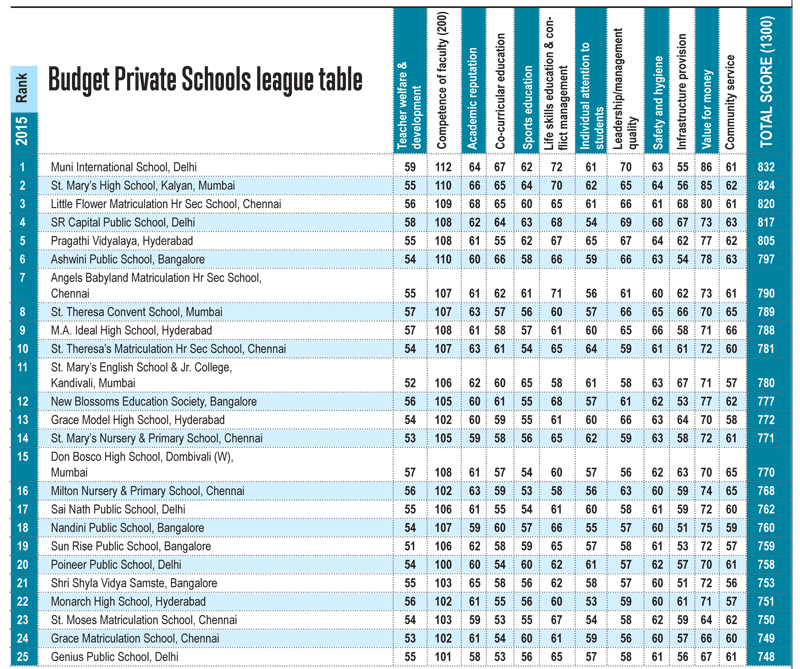For the first time, budget private schools which have mushroomed countrywide as a response to dysfunctional government schools, are rated and ranked in EWISR 2015
.gif) One of the greatest injustices that post-independence India’s thoroughly discredited neta-babu network has visited upon India’s estimated 200 million bottom-of-the-pyramid households is denial of the right to quality early childhood and primary education. The self-evident import of the observation that “it’s better to teach a man how to fish than give him a fish” attributed to the revered Chinese sage Confucius (551-479 BC), seems to have eluded India’s government economists and central planners.
One of the greatest injustices that post-independence India’s thoroughly discredited neta-babu network has visited upon India’s estimated 200 million bottom-of-the-pyramid households is denial of the right to quality early childhood and primary education. The self-evident import of the observation that “it’s better to teach a man how to fish than give him a fish” attributed to the revered Chinese sage Confucius (551-479 BC), seems to have eluded India’s government economists and central planners.
As a response to persistent under-funding of education, particularly early childhood and elementary education by the Central and state governments for over six decades, the great majority of the country’s 1.20 million government — especially state government — schools have degenerated into dysfunctional hell-holes defined by crumbling infrastructure, multi-grade teaching, insufficient toilets, drinking water, electricity and pathetic learning outcomes. This elephant in the room is blithely ignored by the political and middle classes (and the media) who are uniquely divorced from the government/public school system and spare no expense to ensure their children are safely enroled in the country’s 237,000 private ‘recognised’ schools which dominate the annual EducationWorld India School Rankings (EWISR).
With private schools shaped and designed for India’s 250-million-strong middle class unaffordable for the poor majority, budget private schools (BPS) — ‘unrecognised’ by the education ministries of the Central and state governments — have mushroomed countrywide as an entrepreneurial response to dysfunctional government schools.
According to the Centre for Civil Society, a highly-respected Delhi-based think tank, the number of BPS — typically crammed into small premises (often rented), family homes, and even rooms above shops, charging tuition fees ranging from Rs.70-150 per month in rural areas, and Rs.200-600 in urban India — has risen to 300,000 with a staggering aggregate enrolment of 60 million children. While admittedly BPS tend to be over-crowded and under-provided, a growing number of poor but aspirational households obviously — as their massive aggregate enrolment testifies — prefer them to government schools.
Yet instead of helping BPS edupreneurs to improve and upgrade their institutions with financial aid, advice and soft loans, education ministry officials, invested with vast discretionary powers, are either shaking them down or closing them for non-compliance with s. 19 and the Schedule of the Right of Children to Free and Compulsory Education Act, 2009 (aka RTE Act) which makes it mandatory for all schools to comply with minimal infrastructure and teacher-pupil ratio norms. “By authorising the shut-down of budget private schools which serve poor students, the RTE Act is taking away education instead of guaranteeing it,” says Dr. Parth Shah, president of the Centre for Civil Society (CCS).
On the premise that India needs as many and as varied schools as possible, EducationWorld has strenuously opposed the discriminatory s.19 of the RTE Act whose penal provisions exempt government schools, and on the ground that parental choice — as ruled by the Supreme Court on the medium of instruction issue — should be paramount (see EW report June 2014). Therefore to confer unofficial recognition and appreciation upon the best budget private schools, your editors sought the cooperation of CCS and the National Independent Schools Alliance (NISA estb. 2011), a representative organisation of budget private schools, to shortlist 25 well-managed BPS in several major cities.
Subsequently, field representatives of C fore interviewed 1,168 SEC (socio-economic category) C, D and E parents to rate them on 12 parameters of school education excellence. The ratings awarded were totalled to rank India’s best BPS inter se.
“CCS and NISA forwarded a list of NISA-member BPS in five major cities of India to C fore in June on the presumption that NISA member schools would be more aware than non-member schools of the various parameters of education excellence. Thereafter C fore quizzed a specially constituted base of sample respondents to rate the most well-reputed BPS under each parameter,” says Amit Chandra, associate director (policy advisory) of CCS.
Adds Premchand Palety, promoter-CEO of C fore who personally visited several top-ranked BPS to double check: “Each list of 80-100 schools per city provided by CCS/NISA was shown to a mix of 250 teachers and parents who were asked to rate budget private schools with which they were familiar. Schools rated by less than 25 respondents are not included in the league table. Typically, BPS are small schools promoted by committed edupreneurs who deliver progressive education, including English language learning. Given encouragement, they have the potential to flower into excellent institutions.”
For the first time, a league table rating and ranking India’s Top 25 budget private schools in five cities, which have the potential to bloom into excellent K-12 institutions, is set out below.
